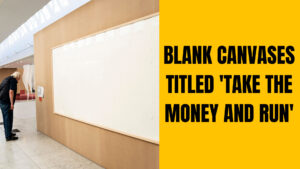
1. A Danish artist who delivered two framed blank canvases titled “Take the Money and Run” must repay the Kunsten Museum of Modern Art about $70,000 it had given him to reproduce artworks involving physical currency, a Copenhagen court ruled on Monday.
2. The museum had commissioned the artist, Jens Haaning, to recreate two of his earlier works, “An Average Austrian Year Income” (2007) and “An Average Danish Annual Income” (2010), which displayed cash in euros and Danish kroner. For the purpose of his new artworks, Haaning was given 532,549 kroner, according to the museum director, plus fees and expenses.
3. But Haaning surprised the museum by sending it “Take the Money and Run,” which was included in an exhibition from September 2021 to January 2022. When the exhibition closed, Haaning did not return the money, prompting the museum, which is in the northern city of Aalborg, to file a lawsuit.

What qualifies as a piece of art for you personally? What criteria must it meet? Why?
4. The Copenhagen court pointed to the contract and the disbursement receipt, which both stated that the kroner were to be repaid after the exhibition. Though Haaning has said he did not intend to return the money, the court added, the museum never agreed to those terms.
5. In determining what Haaning owed, the court allowed him to keep almost $6,000 from the museum’s loan to compensate him for the showing of “Take the Money and Run.”
6. Haaning said in an interview on Tuesday that the ruling was what he expected and that he has not repaid the money because, he argued, keeping the money is itself the art. “I will go so far to say that the piece is that I have taken the money,” he said. “The two empty frames is actually a representation of the concept. So more important than the absence of money is that I’ve taken the money.”

Can you describe a piece of (visual) art which has moved you? What is it and why?
7. He acknowledged that he did not fulfill the original commission. “I completed something else,” he said. “You’re asked to show a 10- and a 12-year-old work, and suddenly you have a better concept.” In a statement responding to the decision, Lasse Andersson, the director of the Kunsten Museum, said he would have no comment while the case was proceeding, noting that there was a four-week period for appeals.
8. As part of the original exhibition, the museum posted on its website that “Take the Money and Run” was in a tradition of art “that leaves materials as a trace left behind or a framework for an idea or an action,” and compared it to works by Banksy and Bjorn Norgaard.
9. At the time, the museum added, “Even the lack of money in the work has a monetary value when it is designated as art and thus shows how the value of money is an abstract quantity.”

How important is it to have contextual understanding of a piece of art to appreciate it. The who, when, where and why compared to the final product?
Open discussion about other artists from Japan and abroad which you enjoy the works of, the works themselves and Low art (manga for example) to High art (museum paintings). Bulk of the class is certainly about visual art however this discussion could extend to all mediums.
Supplementary text
The question of what is and isn’t art is a complex and subjective one that has been debated by artists, scholars, and philosophers for centuries. There is no universally agreed-upon method to definitively quantify what qualifies as art, as artistic expression can take many forms and can be deeply personal and cultural. However, several approaches and criteria have been proposed to help evaluate and discuss what is considered art:
1. **Intention and Expression:** One common criterion is that art is the result of intentional creative expression. Artists often create with the intention of conveying a message, emotion, or idea. This intention distinguishes art from random or unintentional arrangements of elements.
2. **Aesthetic Quality:** Many people associate art with aesthetic qualities, such as beauty, balance, and harmony. While not all art is conventionally beautiful, the aesthetic experience often plays a significant role in our appreciation of it.
3. **Creativity and Originality:** Art often involves a degree of creativity and originality, where the artist brings a unique perspective or approach to their work. The element of novelty can be a factor in considering something as art.
4. **Cultural and Historical Context:** The cultural and historical context can shape our understanding of what is considered art. Objects or practices that may not be seen as art in one context can be highly regarded as art in another.
5. **Reception and Interpretation:** Art relies on the viewer’s interpretation and engagement. Something may be considered art because it elicits an emotional or intellectual response in individuals, and it sparks dialogue and discussion.
6. **Expert Consensus:** In some cases, art experts, critics, and institutions like museums and galleries play a role in designating what is considered art. Their recognition and promotion of certain works can influence their status as art.
7. **Intent to Challenge or Question:** Some contemporary art deliberately challenges traditional notions of art. Art can be a way to provoke thought, challenge conventions, and push boundaries.
8. **Functional vs. Non-Functional:** Objects or creations that primarily serve a practical or functional purpose may not be considered art. However, when these objects are intentionally transformed into something with artistic significance, they can become art.
9. **Time and Evolution:** Over time, societal perspectives on what constitutes art can evolve. Forms of art that were once unconventional or controversial may come to be accepted as art as societal norms change.
It’s important to recognize that the definition of art is subjective and varies from person to person and culture to culture. What one person considers art, another may not. The open-ended nature of this question allows for a rich diversity of artistic expression and interpretation, which is a fundamental aspect of the world of art.
Swiss style (international typographic style) 1950’s / 1970’s
Memphis design 1980’s / mid 1990’s
Y2K mid-late 1990’s / 2000’s
Frutiger Aero 2000’s
Corporate Memphis / Flat 2010’s / 2020’s
Soundcloud
Bandcamp
Youtube



